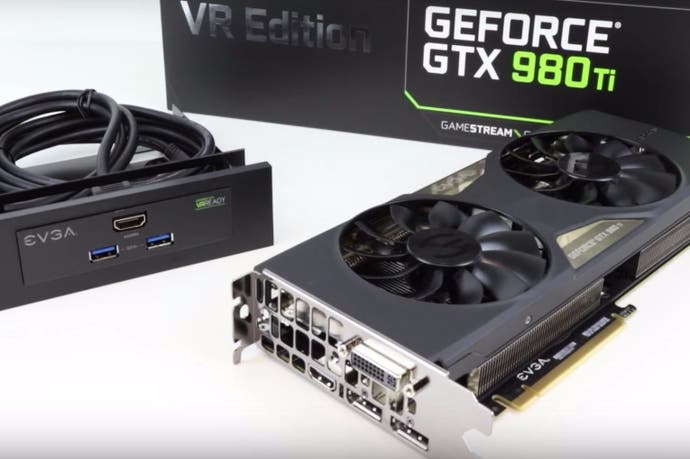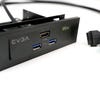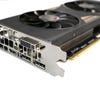EVGA GeForce GTX 980 Ti VR Edition review
Unique hardware modifications, designed with VR in mind.
Just how much graphics power do you need to get a great virtual reality experience? Oculus released a series of recommended specs which - by and large - work well on its launch line-up, but the bottom line is that you'll need more power to really get the job done across the whole range of VR titles. If you want sustained performance in Project Cars, the recommended R9 290 and GTX 970 isn't really going to cut it. You're going to need more horsepower, and right now the GTX 980 Ti seems like the best bet.
It's with that in mind that EVGA has released its own, special VR edition of Nvidia's top-tier 28nm graphics hardware. It's actually available in two flavours - the standard Nvidia reference design based on its familiar 'blower' cooler, along with a custom version based on EVGA's own ACX 2.0+ SKU. On the face of it, both cards look very much like existing products in the marketplace, but the reality is that EVGA has customised the board and added in a piece of bespoke hardware designed to add a little more user-friendliness to your VR set-up.
The extra kit comes in the form of a 5.25-inch expansion bay, slotting into your PC in place of an optical drive (remember those?). It's a really simple design, effectively giving you a front-mounted HDMI output along with an additional brace of USB 3.0 ports. Internal connectivity is intriguing. The USB aspect is handled very simply - there's a standard hub connection that attaches to an internal USB 3.0 header on your motherboard (obviously, make sure you've actually got one first).
But it's the HDMI expansion that is more intriguing. Rather than snake out a cable to the rear of your PC, blocking out an existing port, the EVGA VR Edition adds an additional HDMI port to the GPU, positioned on the front of the card. It's an entirely standard HDMI port too, so in theory it could be used for other purposes - like a modded chassis with a built-in display, for example. For the purposes of VR though, it simply attaches to the expansion bay, relocating all of the required ports from the rear of the PC to the front.
It's all about convenience really. Front-mounted ports allow you to attach and remove your VR headset much more easily, as opposed to ferreting around at the rear of your PC. It also serves to ensure that your VR headset doesn't rob you of any video or USB ports that may well be occupied elsewhere. The interior HDMI port in particular is quite useful - it is indeed an extra port, and we successfully ran two HDMI displays independently using both internal and external ports simultaneously. If you have an HDMI display attached, you don't need to remove it to attach your VR headset.
But other than that, it is a standard GTX 980 Ti - running at reference clocks no less. EVGA sent us the ACX 2.0+ version, and it's a lovely card with some decent features, including an energy efficient three-phase, six-slot motor, double ball bearings and a refined blade design offering more heat dissipation with lower weight. The PCB features a memory and MOSFET cooling plate, and 0db silent operation when the GPU temperature is under 60 degrees celsius. EVGA's aim here is to reduce board power consumption as much as possible, the idea being that this additional energy can be re-routed into your overclock.
At stock clocks, we noted no real difference to the reference GTX 980 Ti we have in-house, which tops out with a boost clock that maxes out in the region of 1175-1200MHz. It's a good overclocker too - though to be fair, we yet to find a GM200 card that isn't. Our standard Maxwell strategy of adding +200MHz to the core clock and +400MHz to the GDDR5 memory works a treat here, taking us up to 1400MHz with 7.5gbps throughput on the RAM. The EVGA model topped out for us at 1425MHz stable, with 8gbps on the RAM. That's a good result, but offers no tangible performance advantage compared to the safe and stable +200/+400 combo. The custom cooler does a great job though, and the overclocked boost looked solid - something you won't really get with the reference design.
In effect, what EVGA has delivered is a solid version of the GTX 980 Ti with excellent build quality, and it's paired with a cute, but not entirely necessary hardware modification that should benefit VR owners - well, depending on which VR headset you own. In terms of justifying the price premium, the real question here is obvious: to what extent are those extra ports actually useful? There are actually two answers here - and it all depends on which VR headset you own.
If there's one criticism we have of the epic HTC Vive, it's the involved installation plus the daunting array of cabling. In an attempt to rationalise the set-up, a breakout box is provided, designed to hook up the necessary USBs and HDMIs - and MiniDisplayPort too - on the rear of your PC to a more user-accessible location. In effect, you choose where that is, depending on where you position the box. HTC also provides a sticky-pad to keep this little peripheral locked in place.

Now, in theory, having the necessary cabling here tucked away inside your PC and attached to EVGA's expansion bay is a good idea. Unfortunately, the Vive breakout box also supplies power to the headset too, not to mention handling the bluetooth trafficking with the twin tracking base stations - and there's nothing on the EVGA hardware to replace that. In short, not only is the breakout box necessary, it also means that you don't need the expansion bay at all, even though it would have been a neater solution overall.
However, if you have the Oculus Rift, there is some added convenience here - there is no breakout box required and everything is powered by the USB hook-ups. The EVGA hardware is palpably useful here, providing that added convenience the firm was looking to deliver. It's not essential of course, but we can safely assume that EVGA knows this: the GTX 980 Ti VR Edition is what it is and makes no apologies for it - it's a niche product aimed at a certain type of power user, and has the premium price-point to match.
VR additions aside, the GTX 980 Ti VR Edition is an excellent example of the card. We re-ran a few benchmarks and found that even at stock clocks, it offers virtually all of the performance of Nvidia's top-tier offering - the Titan X. You lose the odd frame or two, but the gameplay experience is essentially like-for-like. Couple that with the remarkable overclocking headroom and it remains a top-tier performer. But that added price price premium cannot be ignored. It's commanded by a combination of the top-tier brand, the quality of the components and the build, not to mention the VR additions. But the extent of the value offered here is something worthy of serious consideration, especially bearing in mind the recent Pascal reveal, where Nvidia looks intent on offering the same level of performance seen here in a £300/$380 product...









